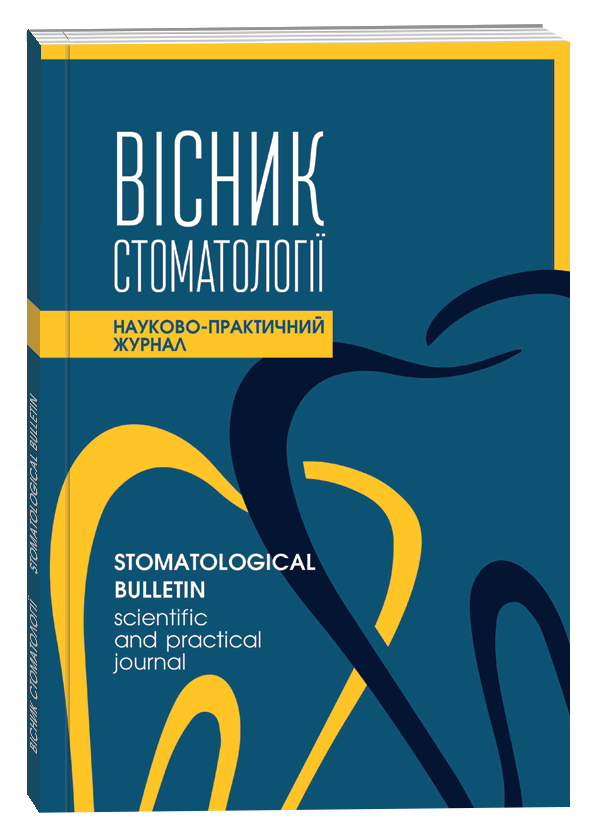STUDY OF THE INFLUENCE OF VARIANTS OF PERSISTENT NASOPHARYNGEAL OBSTRUCTION IN CHILDREN AND ADOLESCENTS WITH DENTAL ABNORMALITIES ON THE CHOICE OF EFFECTIVE TREATMENT TACTICS
DOI:
https://doi.org/10.35220/2078-8916-2023-48-2.23Keywords:
Dento maxillofacial anomalies, persistent nasopharyngeal obstruction, allergic rhinitis, pharyngeal tonsil hypertrophy, combined pathologyAbstract
The goal of the work. Study of the structure of prerequisites and causes of dento-maxillofacial anomalies (DMA) in children and adolescents associated with persistent nasopharyngeal obstruction depending on age and the effectiveness of complex treatment of DMA depending on the fact of timely surgical intervention in the nasopharyngeal area. Research materials and methods. We examined 149 patients who had DMA due to persistent difficulty in nasal breathing (DNB). The age of the patients ranged from 6 to 18 years, 77 of them were boys and 71 were girls. The preliminary selection of patients included the collection of anamnesis, endoscopic examination of the ENT organs, rhinomanometry, consultation with an allergist with general and specific allergy diagnostics (in case of suspected allergic rhinitis) and an orthodontist (with teleradiogram, panoramic radiography of the jaws, radiograph of the palatal suture, radiograph of the hand, CBCT - depending on the needs of each specific orthodontic pathology). In order to study the structure of the prerequisites for the occurrence of DMA with DNB, patients were divided into 2 groups depending on age. The first main group included 78 children aged 6 to 12 years, the second – 71 children aged 13 to 18 years. The control group included 32 patients with DMA with otorhinolaryngological diseases that did not lead to persistent nasopharyngeal obstruction, who did not have mouth breathing. In order to study the effectiveness of the treatment of patients with DMA with persistent DNB, 101 patients aged 6 to 18 years who were shown surgical treatment in the nasopharyngeal area were divided into 2 main groups depending on the presence or absence of allergic rhinitis (AR) in this particular patient. The main group №1 included 36 patients diagnosed with any variant of the diagnosis + AR. 34 patients with any type of diagnosis without AR were included in the main group № 2. The control group consisted of 31 patients with a similar otorhinolaryngological diagnosis, in whom surgical treatment was not carried out due to lack of consent or was carried out late, at a later age after long attempts at conservative treatment. The results of their discussion. The article presents the results of the distribution of otorhinolaryngological nosologies among children and adolescents with DMA with persistent nasopharyngeal obstruction (PNFO), taking into account age categories. It has been shown that only 7.38% of patients with DMA with SNFO have an otorhinolaryngological diagnosis with one nosology. Whereas in patients with SCA without SNFO obstruction, this percentage is 96.88%. An assessment of the results of treatment of patients with DMA with SNFO is given, depending on the fact of timely surgical intervention in the nasopharyngeal area. Conclusions. More often (at Р<0,05) in children aged 6–12 years, DMA with SNFO is accompanied by hypertrophy of the pharyngeal tonsil (HPT), and in children aged 13–18 years – AR at (Р<0,01). 2. A factor in the occurrence of DMA with SNFO is a combination of several reasons from the nasopharyngeal zone in a particular patient, which complicates the course of the disease with a more guaranteed development of DMA. 3. AR is the leader that accompanies the occurrence of DMA in SNFO in both age groups, but was never the sole cause of this pathology in our study. 4. Timely surgical intervention in the nasopharyngeal zone in case of DMA with SNFO reliably at P<0,05 leads to positive results of DMA treatment 1 year after the end of orthodontic treatment. 5. AR can be an aggravating factor in the treatment of DMA with SNFO, as a factor of persistent DNB, which cannot be influenced by surgical intervention.
References
Мельник В.С., Зомбор К.В., Білищук Л.М., Мельник С.В. Поширеність зубощелепних аномалій у дітей дошкільного віку. Інновації в стоматології. 2023. №(1). С. 52–57. https://doi.org/10.35220/2523-420X/2023.1.9
Номеровська О.Є., Карман А.А., Горохівський В.Н., Дієва Т.В., Дієв Є.В., Шнайдер С.А. Про необхідність проведення наукових досліджень тривалості сучасних видів ортодонтичного лікування зубощелепних аномалій та деформацій. Інновації в стоматології. 2022. №(1). С. 32–38. https://doi.org/10.35220/2523-420X/2022.1.5
Стасюк О.А. Взаємозв'зок положення голівок скроневоніжньощелепного суглоба та верхніх дихальних шляхів при патології прикусу I-II класу. Актуальні проблеми сучасної медицини. Том 22. Випуск 22 (78). 48-52. doi https://doi.org/10.31718/2077-1096.22.2.48
Стасюк О.А., Виженко Є.Є., Сокологорська-Никіна Ю.К., Куроєдова В.Д. Взаємозв'язок патології прикусу І-ІІ класу та верхніх дихальних шляхів. Актуальні проблеми сучасної медицини. 2021. Т . 2 1. В. 3. С. 173-177. DOI https://doi.org/10.31718/2077-1096.21.3.173
Вишемирська Т.А. Взаємозв’язок виникнення сагітальних аномалій прикусу з порушенням носового дихання. Сучасна стоматологія. 2019. №5. С. 92-95.
Farronato M, Lanteri V, Fama A, Maspero C. Correlation between Malocclusion and Allergic Rhinitis in Pediatric Patients: A Systematic Review. Children (Basel). 2020. №27(7). Р. 12-260.
Ashley E., Gerardo R., Shankar Rengasamy V. Craniofacial growth: current theories and influence on management. Oral and Maxillofacial Surgery Clinics. 2020. № 32(2). Р. 167-175.
Haskell J., McCrillis J., Haskell B. et al. Effects of mandibular advancement device (MAD) on airway dimensions assessed with cone-beam computed tomography. Seminars in Orthodontics. 2009. №15(2). Р. 132-158.
Сокологорська-Никіна Ю. К., Куроєдова В. Д. Результати комплексного стоматологічного обстеження порожнини рота дітей з вадами слуху. Актуальні проблеми сучасної медицини. 2017. Т. 17, Вип. 3. С. 246-249. –
Смоляр Н. І., Лесицький М. Ю. Поширеність аномалій зубних рядів у дітей 6–16 років. Клінічна стоматологія. Дитяча стоматологія. 2021. №2. С. 63-70. DOI 10.11603/2311-9624.2021.2.1204
Holty J, Guilleminault C. Maxillomandibular advancement for the treatment of obstructive sleep apnea: a systematic review and meta-analysis. Sleep medicine reviews. 2010;14(5):287-297.









